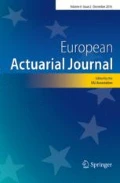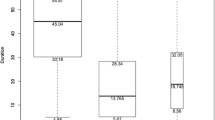Abstract
A general definition of the 1-year premium risk in non-life insurance is given, which fully covers the risk associated with the change in premium provision. Based on the chain ladder method, a simple predictor is provided and a new analytic formula for the estimated prediction error is derived. Furthermore, the relationship with the claims development result is explicitly worked out. Finally, the formula is applied to publicly available data of a legal protection insurance company falling under Solvency II; and the resulting confidence intervals are compared to the reported premium risk capital.
Similar content being viewed by others
Notes
For a definition of written premiums as well as earned premiums in the context of Solvency II see Definitions 11 and 12 in Art. 1 of the Commission Delegated Regulation (EU) 2015/35.
The run-off rate is the fraction of earned premiums that run off each year; and we assume that this takes place anticipatively, at the beginning of each year. This is to substitute for the missing information about the true run-off pattern. In the calculations, for any given run-off rate r, the sum of earned premiums is bounded above by
$$\begin{aligned} \sum _{t=1}^T C_{n+t,0} = 1.058\cdot C_{n,0}\sum _{t=1}^T (1-r)^t \le 1.058\cdot C_{n,0}\frac{1-r}{r}. \end{aligned}$$(49)The analogous bound holds for new business.
According to Art. 18 of [2] contracts under Solvency II are considered active only within their respective contract boundary, which is essentially determined by unilateral cancellation rights of the insurance company.
For details of the methodology behind the calibration of the Solvency II premium risk capital we refer the reader to [3].
References
BaFin, Statistik über Stand und Entwicklung der deutschen Versicherungsunternehmen: https://www.bafin.de/DE/PublikationenDaten/Statistiken/Erstversicherung/erstversicherung_node.html
Commission Delegated Regulation (EU) 2015/35 of 10 October 2014 supplementing Directive 2009/138/EC of the European Parliament and of the Council on the taking-up and pursuit of the business of insurance and reinsurance (Solvency II)
Committee of European Insurance and Occupational Pensions Supervisors (2010) Solvency II calibration paper
DEVK Rechtsschutz-Versicherungs-AG (2018) Geschäftsbericht: https://www.devk.de/media/content/geschaeftsberichte/gb2018/DEVK-GB2018-Rechtsschutz-AG.pdf
Diers D, Linde M (2013) The multi-year non-life insurance risk in the additive loss reserving model. Insur Math Econ 52(3):590–598
Diers D, Linde M, Hahn L (2016) Addendum to ’The multi-year non-life insurance risk in the additive reserving model’ [Insurance Math. Econom. 52(3) (2013) 590–598]: Quantification of multi-year non-life insurance risk in chain ladder reserving models. Insur Math Econ 67:187–199
DEVK Rechtsschutz-Versicherungs-AG (2018) Solvency and Financial Condition Report: https://www.devk.de/media/content/download/unternehmen/2018/SFCR-Bericht-DEVK-Rechtsschutz-2018.pdf
Directive 2009/138/EC of the European Parliament and of the Council of 25 November 2009 on taking-up and pursuit of the business of insurance and reinsurance (Solvency II)
Gisler A (2019) The reserve uncertainties in the chain ladder model of Mack revisited. Astin Bull 49(3):787–821
Mack T (1993) Distribution-free calculation of the standard error of chain ladder reserve estimates. Astin Bull 23(2):213–225
Merz M, Wüthrich M (2008) Modelling the claims development result for solvency purposes. In: Casualty Actuarial Society E-Forum, pp 542–568
Ohlsson E, Lauzeningks J (2009) The one-year non-life insurance risk. Insur Math Econ 45(2):203–208
Acknowledgements
We would like to thank the referees for their clear critique that helped us revise our paper so as to be sound from an actuarial as well as from a statistical point of view.
Author information
Authors and Affiliations
Corresponding author
Additional information
Publisher's Note
Springer Nature remains neutral with regard to jurisdictional claims in published maps and institutional affiliations.
Supplementary Information
Below is the link to the electronic supplementary material.
Appendix
Appendix
Proof of Proposition
Part 2: Using (9),
Part 3 is a direct consequence of Parts 1–2. \(\square\)
Rights and permissions
About this article
Cite this article
Fischinger, D., Gach, F. The 1-year premium risk. Eur. Actuar. J. 11, 655–675 (2021). https://doi.org/10.1007/s13385-021-00262-5
Received:
Revised:
Accepted:
Published:
Issue Date:
DOI: https://doi.org/10.1007/s13385-021-00262-5




